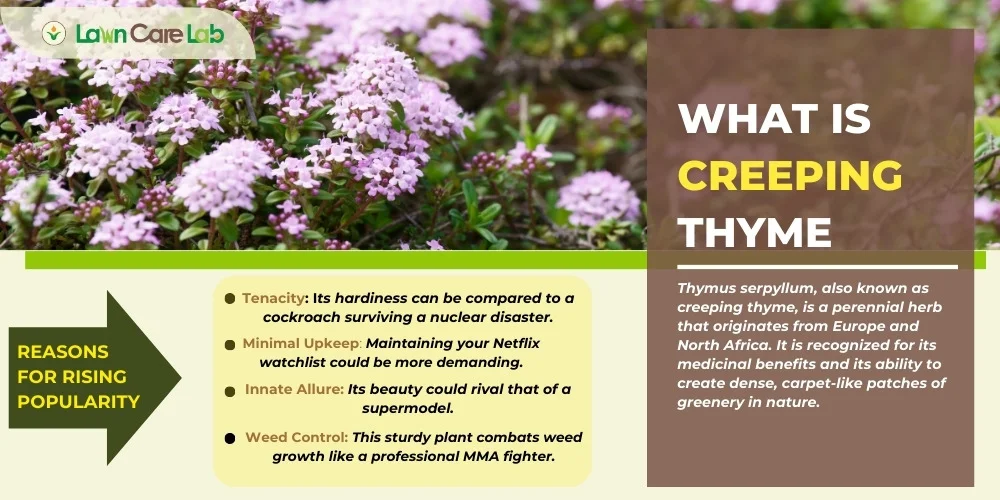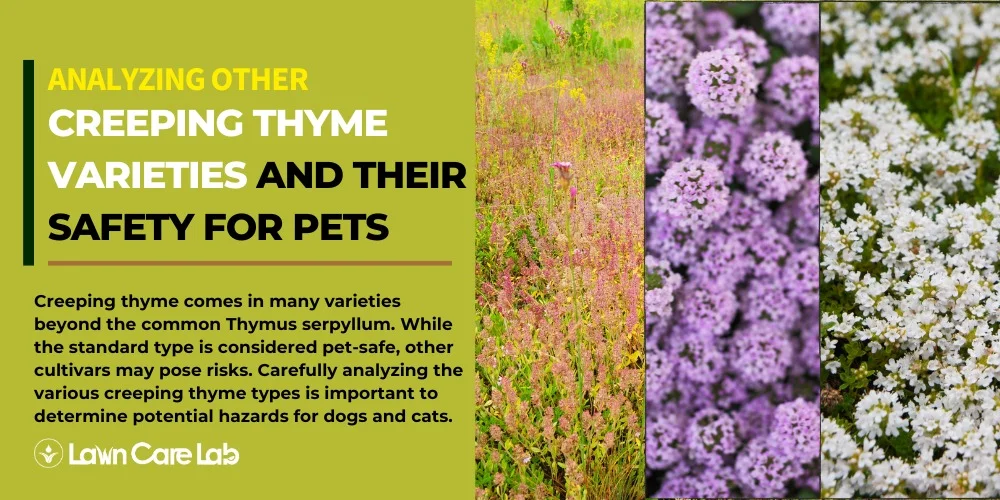As a pet owner passionate about gardening, you may question whether your fondness for creeping thyme could harm your beloved pets. You’re in the right place! We’re exploring the exact topic of creeping thyme’s safety for pets.
So, prepare to delve into this intriguing topic of Creeping Thyme and Pets’ Safety. A Definitive Guide for Dog and Cat Owners.
Table of Contents
Creeping Thyme and its Popularity Among Gardening Enthusiasts

Creeping Thyme, this modest herb is capturing attention for its aesthetic appeal, adaptability, and remarkable capacity to transform even the most barren flower beds into vibrant green spaces.
The gardening community is enthralled by thyme – let’s explore the reasons behind this tiny plant’s growing fame!
What is Creeping Thyme
Thymus serpyllum, also known as creeping thyme, is a perennial herb that originates from Europe and North Africa. It is recognized for its medicinal benefits and its ability to create dense, carpet-like patches of greenery in nature.
Creeping thyme is both medicinal and aesthetically pleasing. It’s great for rock gardens and borders and as an alternative to lawns. It’s like having a natural pharmacy in your yard!
Reasons for the Rising Popularity of Creeping Thyme in Gardens
Gardeners adore Creeping Thyme for its durability, effortless upkeep, and gorgeous aesthetics.
Below are the top 4 reasons for its increasing presence in gardens:
- Tenacity: Its hardiness can be compared to a cockroach surviving a nuclear disaster.
- Minimal Upkeep: Maintaining your Netflix watchlist could be more demanding.
- Innate Allure: Its beauty could rival that of a supermodel.
- Weed Control: This sturdy plant combats weed growth like a professional MMA fighter.
Understanding the Safety of Creeping Thyme for Pets

Worried if your creeping thyme is safe for pets?
Let’s delve into this horticultural mystery and uncover information on the safety of creeping thyme for dogs and cats.
Is Creeping Thyme Safe for Dogs?
Rest assured that Creeping Thyme will not harm your furry friend.
See the facts and misconceptions surrounding this herb.
Creeping Thyme and Dogs: A Closer Look
You might be curious about the impact of Creeping Thyme on your canine companion.
Here’s a comprehensive overview:
- Creeping Thyme is non-toxic, thereby eliminating any severe concerns.
- However, too much thyme may not be good for dogs’ digestion.
- Ingesting small quantities of this herb probably won’t lead to significant issues.
- Keeping your dog away from your herb garden is advised for utmost safety.
Always prioritize safety, even when it comes to horticultural activities!
Debunking the “Creeping Thyme Poisonous to Dogs” Myth
Creeping Thyme is a safe plant for dogs and will not cause them to consume other plants.
Rest assured, this verdant companion is as safe as a dog’s favorite chew toy and provides double the enjoyment when they frolic in it!
Is creeping thyme safe for cats?
Let’s discuss the safety of herbs for cats and find out if your furry companion can frolic in the thyme fields without any risks.
Exploring the Safety of Creeping Thyme for Feline Friends
Despite there being no immediate threats, vigilant supervision is required when cats are in the vicinity of creeping thyme.
Follow these four safety guidelines for your cat:
- Observe their engagement with the plant.
- Restrict them from consuming substantial quantities.
- Be alert for any negative reactions.
- Seek veterinary advice when necessary.
It’s critical to remember that although curiosity might not be fatal, it could lead your feline into problems involving thyme.
Analyzing Other Creeping Thyme Varieties and Their Safety for Pets

Before allowing your pets to play in your garden, it’s important to ensure that Red Creeping Thyme and Snow in Summer plants are safe for them.
Is Red Creeping Thyme Safe for Pets
Learn about the safety of Red Creeping Thyme for pets before introducing it to your garden.
Detailed Analysis of Red Creeping Thyme and Pet Safety
The safety considerations of Red Creeping Thyme for your cherished pets:
- Supervised Interaction: Although safe, ensure Fido or Whiskers don’t start feasting on it.
- Discourage Overeating: Deter them from excessive nibbling; it could lead to digestive issues.
- Monitor Outdoor Activities: Maintain vigilance during their garden escapades.
- Limit Consumption: Prevent them from treating it as an inexhaustible food source.
Snow in Summer: Toxic or Safe for Dogs
We’re not discussing Frosty’s magical material but rather a specific plant!
Let’s investigate if this white-flowering Creeping Thyme is safe for dogs.
Scrutinizing the Safety of Snow in Summer for Dogs
Snow in Summer may cause dog discomfort if ingested in large amounts, but it is not directly harmful.
- Monitor your pet – Prevent them from becoming a plant eater.
- Ensure proper hydration – Water aids in digestion.
- Practice restraint – Small bites are acceptable; overindulgence is not!
- Have your pet’s contact details handy – In case of adverse reactions.
Remember that humor is a great healer, but plant knowledge is equally important!
Creeping Thyme and Pets Interaction
Let’s talk about the impact of dog urine on your creeping thyme. It’s important for gardening with pets.
Creeping Thyme and Dog Urine: What You Need to Know
You might be concerned if your dog’s regular urination is causing your thyme to yellow.
Let’s understand the effects of your pet’s urine on your gardening endeavors.
Understanding the Impact of Dog Urine on Creeping Thyme
While Creeping Thyme is a robust plant, consistent exposure to dog urine could damage it.
Here are the key points to consider:
- Dog urine is not beneficial for plants.
- The health of your Thyme may deteriorate due to dog urine.
- Occasional exposure might be tolerated, but regular exposure is detrimental.
- Ensure only you are responsible for watering the plant.
Keep in mind: Prioritize your pets’ and plants’ well-being!
Final Thoughts: Making Your Garden Safe and Enjoyable for Pets
As an avid gardener and pet lover, there’s good news for you. Your pets can enjoy and play around your creeping thyme in your dog-friendly backyard without any harm.
You’re a keen gardener with a cherished pet, keen on cultivating Creeping Thyme.
Yet, before you transform your garden into a thyme-filled haven, it’s essential to consider your pet’s safety.
We will also discuss alternative plants that are pet-friendly and won’t risk a surprise visit to the vet for your furry friends.
Precautions to Take When Growing Creeping Thyme with Pets
To keep pets safe, take precautions when growing Creeping Thyme.
Follow these four steps to protect your garden and furry friends.
- Constant surveillance: Never leave your pets unsupervised around the Creeping Thyme.
- Establish a pet-exclusion area: Erecting a physical barrier can prevent your pets from getting too close to your plants.
- Effective training: Instruct your pets to avoid treating this as a new plaything or restroom.
- Monitor for unusual behavior: Seek immediate veterinary help if your pet exhibits strange behavior after being near the plant.
Primarily, the safety of all should be prioritized! Your garden should be a source of happiness for all its visitors, including your pets!
Alternative Pet-Safe Plants to Consider for Your Garden
Consider incorporating pet-safe plants in your garden. Some options include spider plants, Boston ferns, and Areca palms. Spider plants are known for their resilience and non-toxic nature, making them ideal for those who may sometimes forget to water their plants.
Next on the list is the Boston fern. This non-toxic plant is perfect for shaded areas and thrives in high humidity, making it an excellent choice for bathroom decoration while ensuring the safety of your pets.
Lastly, the Areca palm is a green oasis that is as safe for your pets as it is beneficial for the air quality in your home. This tropical plant will not harm your pets if ingested and serves the additional air purification function.
Enjoy your gardening endeavor!
FAQ on Creeping Thyme and Pets’ Safety
What Are the Specific Health Benefits of Creeping Thyme for Cats and Dogs?”
How Can I Introduce Creeping Thyme to My Pet’s Diet?”
What Are the Potential Allergic Reactions My Pet Might Have to Creeping Thyme?
How Does Creeping Thyme Compare to Other Pet-Safe Plants in Terms of Maintenance and Growth
Are There Any Specific Breeds of Dogs or Cats That Should Avoid Creeping Thyme?”
- How to Create a Lawn Care Schedule for Southern Climates - October 30, 2024
- How to Use Compost Tea to Boost Lawn Growth and Soil Health - October 23, 2024
- The Best Grasses for Saltwater-Exposed Lawns: Coastal Lawn Care - October 17, 2024




